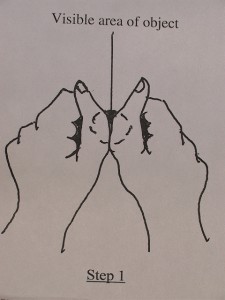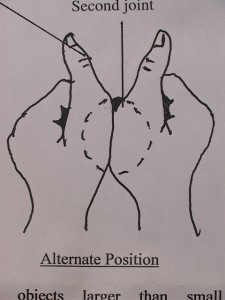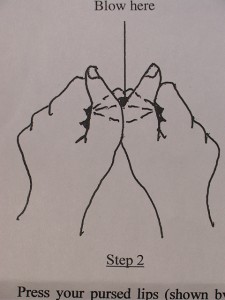Acorn caps can be used as whistles, if you know how to do it. In North America both thumbs are used. In Europe, only the index and middle finger of one hand are used. No one knows when or where this arcane and obscure skill originated or why there are two different styles of whistling with acorn caps.
I am thankful that I learned the North American style first because once I applied the skill to small seashells my fingers were free to wrap around shell bodies. I drilled pitch holes into logarithmic spiral shells, under where my finger tips touched the shell whorls and found the musical scales, but that’s another story told elsewhere throughout this blog.
I call the ‘acorn cap whistle skill’ thumbouchure. It is the way both thumbs are used to cover and seal the opening of a shell or other concave object to make sound.
There are two North American thumbouchure positions. The size of the object or shell instrument opening (aperture) relative to the width of the players thumbs determines which position will be used. The first (standard) thumbouchure position is used with small shell openings (1/4″ – 2″ wide) and is made as follows:
make two fists with thumbs on top. Bring both fists evenly together so that the thumb joints of each hand are pressed evenly together. With thumbs still touching separate both fists a few inches apart, like your thumbs are hinged. You will now be looking at the back of each fist. Push thumbnails evenly apart to form a wedge shaped opening above the thumb joints. This wedged shaped opening is called the wind way. Thumbs stay pressed together below the wind way.
The second position is used with larger shell openings (2″ – 4″) and is made as follows: same as standard thumbouchure position except separate the thumbs at the second joints to create the wind way. An alternate way to do this that allows the fingers of the right hand to more easily touch the shell body is to press the right thumb joint against the left thumb knuckle (second thumb joint) The meaty part of the left thumb will be used to cover and seal three quarters of larger shell openings. The right thumb will cover the remaining area of the opening and make the wind way.
Once the shell or concave object has been positioned under the thumbs using the first or second thumbouchure positions it is time to place the lips on the thumbs and blow breath through the wind way.
The wind way is the area at the bottom of the wedged shaped opening created by the parted thumbs. Keeps your lips soft and shaped like you’re saying the word ‘who’. Press both lips onto your thumbs so that the breath exits the mouth only from under the upper lip. The bottom lip is pressed onto the thumbs a bit below the wind way.The breath strikes the exposed rim of the object and resonates the air inside the object.
The smaller the object the faster the breath needs to be. Puff the cheeks out and blow forcefully when using small objects such as acorn caps, bottle tops, small clam shells or other small shells, thimbles or hard uncooked seashell pasta. Blow gently for larger objects. Make adjustments until you hear sound. Thumbouchure creates rim blown whistles out of many manufactured and naturally occurring objects. Have fun. Enjoy!

